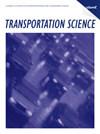A New Family of Route Formulations for Split Delivery Vehicle Routing Problems
IF 4.8
2区 工程技术
Q1 OPERATIONS RESEARCH & MANAGEMENT SCIENCE
引用次数: 1
Abstract
We propose a new family of formulations with route-based variables for the split delivery vehicle routing problem with and without time windows. Each formulation in this family is characterized by the maximum number of different demand quantities that can be delivered to a customer during a vehicle visit. As opposed to previous formulations in the literature, the exact delivery quantities are not always explicitly known in this new family. The validity of these formulations is ensured by an exponential set of nonrobust constraints. Additionally, we explore a property of optimal solutions that enables us to determine a minimum delivery quantity based on customer demand and vehicle capacity, and this number is often greater than one. We use this property to reduce the number of possible delivery quantities in our formulations, improving the solution times of the computationally strongest formulation in the family. Furthermore, we propose new variants of nonrobust cutting planes that strengthen the formulations, namely limited-memory subset-row covering inequalities and limited-memory strong k-path inequalities. Finally, we develop a branch-cut-and-price (BCP) algorithm to solve our formulations enriched with the proposed valid inequalities, which resorts to state-of-the-art algorithmic enhancements. We show how to effectively manage the nonrobust cuts when solving the pricing problem that dynamically generates route variables. Numerical results indicate that our formulations and BCP algorithm establish new state-of-the-art results for the variant with time windows, as many benchmark instances with 50 and 100 customers are solved to optimality for the first time. Several instances of the variant without time windows are solved to proven optimality for the first time. Funding: This work was supported by the Conselho Nacional de Desenvolvimento Científico e Tecnológico [Grants 306033/2019-4, 313220/2020-4, and 314088/2021-0], the Région Nouvelle Aquitaine, France [Grant AAPR2020A-2020-8601810], the Agence Nationale de la Recherche [Grant ANR-20-CE40-0021-01], the Fundação de Amparo à Pesquisa do Estado de São Paulo [Grants 13/07375-0, 16/01860-1, and 19/23596-2], and the Paraíba State Research Foundation [Grants 261/2020 and 041/2023]. Supplemental Material: The online appendix is available at https://doi.org/10.1287/trsc.2022.0085 .一种新的分体配送车辆路线求解方法
针对有时间窗和无时间窗的分流配送车辆路径问题,我们提出了一组新的基于路径变量的公式。该系列中的每种配方的特点是在车辆访问期间可以交付给客户的不同需求量的最大数量。与文献中以前的配方相反,在这个新家族中,确切的递送量并不总是明确已知的。这些公式的有效性由一组非鲁棒约束的指数集来保证。此外,我们探索了一种最优解决方案的性质,使我们能够根据客户需求和车辆容量确定最小交付数量,而且这个数字通常大于1。我们使用这一特性来减少配方中可能的交付数量,从而提高该系列中计算能力最强的配方的求解时间。此外,我们提出了非鲁棒切割平面的新变体,以加强公式,即有限记忆子集行覆盖不等式和有限记忆强k路径不等式。最后,我们开发了一个分支削减和价格(BCP)算法来解决我们的公式,该公式富含所提出的有效不等式,并采用了最先进的算法增强。我们展示了在解决动态生成路线变量的定价问题时,如何有效地管理非稳健削减。数值结果表明,我们的公式和BCP算法为具有时间窗口的变量建立了新的最先进的结果,因为具有50和100个客户的许多基准实例首次被求解到最优性。几个没有时间窗口的变量实例被首次求解为已证明的最优性。资金:这项工作得到了国家环境与技术委员会的支持[拨款306033/2019-4、313220/2020-4和314088/20221-0],法国新阿基坦地区[拨款AAPR2020-2020-8601810],国家研究机构[拨款ANR-20-CE40-0021-01],圣保罗国家研究基金会[拨款13/07375-0、16/01860-1和19/23596-2]和帕拉伊巴州研究基金会[261/2020和041/2023]。补充材料:在线附录可在https://doi.org/10.1287/trsc.2022.0085。
本文章由计算机程序翻译,如有差异,请以英文原文为准。
求助全文
约1分钟内获得全文
求助全文
来源期刊

Transportation Science
工程技术-运筹学与管理科学
CiteScore
8.30
自引率
10.90%
发文量
111
审稿时长
12 months
期刊介绍:
Transportation Science, published quarterly by INFORMS, is the flagship journal of the Transportation Science and Logistics Society of INFORMS. As the foremost scientific journal in the cross-disciplinary operational research field of transportation analysis, Transportation Science publishes high-quality original contributions and surveys on phenomena associated with all modes of transportation, present and prospective, including mainly all levels of planning, design, economic, operational, and social aspects. Transportation Science focuses primarily on fundamental theories, coupled with observational and experimental studies of transportation and logistics phenomena and processes, mathematical models, advanced methodologies and novel applications in transportation and logistics systems analysis, planning and design. The journal covers a broad range of topics that include vehicular and human traffic flow theories, models and their application to traffic operations and management, strategic, tactical, and operational planning of transportation and logistics systems; performance analysis methods and system design and optimization; theories and analysis methods for network and spatial activity interaction, equilibrium and dynamics; economics of transportation system supply and evaluation; methodologies for analysis of transportation user behavior and the demand for transportation and logistics services.
Transportation Science is international in scope, with editors from nations around the globe. The editorial board reflects the diverse interdisciplinary interests of the transportation science and logistics community, with members that hold primary affiliations in engineering (civil, industrial, and aeronautical), physics, economics, applied mathematics, and business.
 求助内容:
求助内容: 应助结果提醒方式:
应助结果提醒方式:


